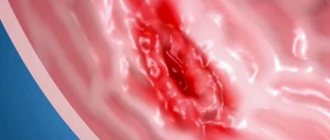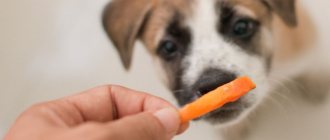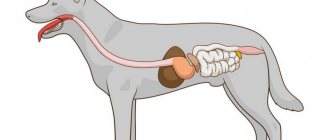Indications for the procedure
Animals are curious, and they not only smell some objects, but also try to taste them.
While walking, a dog may inhale toxic fumes, eat spoiled food, or accidentally swallow foreign objects.
Problems with the gastrointestinal tract also arise when fur gets into the pet’s stomach after licking. These situations cause discomfort in the animal and require urgent action.
Symptoms of poisoning
Signs of indigestion may vary depending on the cause that caused it.
There are also general symptoms that appear in all cases:
- rapid breathing;
weakness;- shiver;
- excessive salivation;
- vomit;
- diarrhea;
- refusal of food;
The pet's behavior changes - it becomes depressed or agitated.
In severe poisoning, convulsive muscle twitching and loss of consciousness are observed.
Prices at the veterinary clinic
If possible, it is necessary to take your pet to a veterinary hospital. The clinic will do everything quickly and professionally.
But this service is paid and costs about 2000 rubles.
Having found out how much the procedure costs, not everyone will be able to pay for it right away, and sometimes the veterinary hospital is far away, and there is no time to waste. Therefore, you should know how to provide help at home.
The process of gastric lavage for a dog
As you might have guessed, this process can bring a lot of discomfort to the pet, so it is better to do the washing together with someone so that you can restrain the dog when necessary. Here is a list of things that may be useful to you in the process:
- Solution intended for washing. To do this, you can use pharmaceutical preparations, soda, manganese or table salt.
- Syringe.
- A large syringe, as well as a tube removed from the IV system. YOU can take any other similar device with which it will be convenient to pour liquid into the animal’s mouth.
- Absorbents. This often includes the simplest remedy - activated carbon; you can use any of its analogues.
- Laxatives.
- Substances intended to coat the walls of the stomach and intestines. Ask your doctor which ones are best to buy.
Here are the two most popular solutions with their preparation methods:
Saline solution . Take a teaspoon of ordinary table salt, then add 6-18 ml of solution depending on the animal’s body weight.
Potassium permanganate . Take a toothpick, dip it in potassium permanganate, and then into a glass of water. Start stirring until the liquid becomes smooth. Let the solution sit a little, then drain off the top layer. Only pale pink liquid should remain, and feed your pet with it.
Now try to induce vomiting, if problems arise, try to press on the walls of the stomach until the urge arises. In rare situations, if the urge was not caused in this way, wrap two fingers in a towel and then press on the root of your pet’s tongue.
Note! Under no circumstances should you hesitate if you find blood, feces or even bile in the remaining vomit. In this case, only a veterinarian can help the pet.
Currently reading:
- Seven Signs and Remedies for Getting Rid of Fleas in Dogs
- How to cure stomach ulcers in dogs
- How to recognize signs of dog poisoning from rat poisons
- Is it worth it or not to include natural food in your dog’s diet?
Algorithm of actions at home
The first thing an owner can do is to make the dog vomit violently. To do this, you can sprinkle a little salt on your pet's tongue (at the base). But a more effective result is obtained by washing with copious amounts of liquid.
If the animal itself is not able to drink, it will have to be helped in this by acting as follows:
- take at least 1 liter of warm, clean water;
- fill a rubber bulb with a capacity of 100-200 ml with liquid;
- insert the end of the device between the teeth on the side of the mouth;
- pour water over the dog's cheek.
The procedure is repeated until the prepared liquid runs out. If you have pharmaceutical or improvised means on hand, you can add them to the water in the required proportions.
After gastric lavage, the pet is given sorbents (Enterosgel, Polysorb or activated carbon).
After half an hour, you need to do an enema with salted water (1 tsp per glass of liquid) or introduce a laxative (vaseline, castor oil).
Features of treatment of puppies and small breed dogs
The solution for gastric lavage of small animals is taken in smaller volumes:
- for small breeds – 0.5 l;
- puppy – 1 glass.
Instead of a syringe, use a large syringe without a needle. To make it more convenient to administer the liquid, it is advisable to have an assistant who will limit the pet’s resistance.
Sorbents are used according to instructions. Dosage is the same as for children under 2 years of age.
Gastric lavage in the clinic and at home
In case of severe poisoning, you cannot risk the health of your four-legged friend; only veterinary specialists will provide effective assistance to the injured dog. Using special devices, doctors will lavage the stomach, give an enema, prescribe symptomatic treatment, and select a therapeutic diet during the dog’s recovery period. But sometimes circumstances arise when it is impossible to bring the injured pet to specialists; in this case, the procedure can be done at home.
How to perform gastric lavage on a dog? First, the animal must be immobilized. For large dogs, use a syringe; for small dogs, a 20 cc syringe without a needle is suitable. The procedure for cleansing the stomach can be carried out using 2 methods:
- Hydrogen peroxide is mixed with an equal amount of water and poured into the pet’s mouth (no more than 15 ml of solution per 1 kg of dog’s weight). Peroxide is administered in small portions every 5 minutes. The procedure is repeated until the animal is unable to induce vomiting. As soon as the vomit takes on a transparent appearance, the victim is given sorbents.
- Warm water with soda is taken into the container (the solution should be at room temperature). The liquid is poured into the mouth in small portions until the animal begins to vomit.
Ridding your pet of fur
Hairballs that enter the digestive system cause no less inconvenience than toxins. They provoke vomiting or persistent constipation.
To help your pet get rid of fur, you can use medications prescribed by your veterinarian.
Or use traditional methods:
- give the dog Vaseline oil (1 tbsp);
- boil and puree the pumpkin pulp (give 7 g for small animals, 14 g for large animals).
The second method to cleanse the stomach is suitable if the pet does not refuse food and a little hair has collected inside.
In what cases is it contraindicated to rinse a dog’s stomach at home?
There are situations in which it is strictly forbidden to rinse an animal’s stomach, these include:
- vomiting black or red. In case of gastrointestinal bleeding, giving the animal something to drink or inducing vomiting is prohibited. By doing this you can increase blood loss;
- poisoning with acids or alkalis. With this type of intoxication, the stomach is cleansed through a tube by a veterinarian;
- disturbance of the animal's consciousness. If the dog is inhibited and reacts poorly to stimuli, it is dangerous to pour water into its mouth; it may choke.
Please note that the dog is not given a rinse if it is acting aggressively. If your pet growls and grins at you, you are afraid that he will bite you, do not risk your own health. Take him to the veterinary hospital.
If a foreign object enters the stomach
Things that enter an animal's stomach or intestines can remain there for a long time without causing any symptoms. And they can cause blockage of the gastrointestinal tract.
Even if foreign bodies do not interfere at first, over time they begin to irritate the mucous membrane and cause the dog to develop gastritis or ulcers.
Flushing will help if the dog has recently swallowed the item and it is too small to pass out of the body on its own.
In other cases, the procedure can provoke a rupture of the walls. Here it is better to proceed as when cleansing the stomach of hair, using laxatives or foods high in fiber.
If your attempt to cleanse the intestines is unsuccessful, it is better to contact a veterinary clinic. Specialists will help you remove the foreign body using endoscopic equipment.
Symptoms of poisoning
You can suspect that a dog has been poisoned by poisons or chemicals based on the following signs:
- the animal often vomits, there is severe weakness and lethargy;
- the mouth begins to smell unpleasant;
- the dog completely refuses food, and sometimes even water;
- mucous membranes turn pale;
- salivation increases;
- body temperature decreases noticeably;
- the animal suffers from diarrhea;
- liquid feces mixed with mucus and blood;
- vomit may contain bile, blood clots, and sometimes feces;
- the abdominal cavity becomes painful;
- weakness and cramps of the hind limbs;
- there is blood coming from the eyes, nose or anus.
How to clean it
Not only water is used for gastric lavage. There are more effective remedies that you can prepare at home.
Solutions for dogs in case of poisoning
| Means | Proportions | Note |
| Hydrogen peroxide | 1:1 | The amount of liquid is taken at the rate of 1 tbsp. per 3 kg body weight |
| Salt | 2 tsp/1 glass of water | Inject 6-20 ml (depending on the size of the dog) |
| Baking soda | 1 tsp/glass of water | |
| Mustard | 1 tbsp. powder/ glass of water | The solution is not recommended for puppies |
Hydrogen peroxide is handled with care: upon contact with saliva, it foams and causes discomfort in the pet.
The solution should be given in small portions of 5-10 ml at five-minute intervals.
Potassium permanganate
Veterinarians have an ambiguous attitude towards this pharmaceutical product. Some experts do not recommend rinsing the dog’s stomach with potassium permanganate, so as not to burn the walls of the esophagus .
Others, on the contrary, put the remedy in 1st place when providing immediate assistance. To avoid consequences, prepare the solution as follows:
- a liter jar is filled with warm water;
moisten the tip of a toothpick and dip it in manganese so that a small amount of crystals remains on it;- rinse in a jar of water;
- stir thoroughly;
- wait until undissolved crystals settle to the bottom;
- filter through 3-4 layers of gauze.
To obtain a weak solution of pale pink color, 0.5 liters of liquid is poured into a clean jar and diluted with the same amount of water. You can safely give such a drug to your pet.
Contraindications to gastric lavage
Many dog owners do not even suspect that rinsing the stomach is sometimes not advisable and even dangerous. Just like feeding your pet milk and egg white. If the dog has suffered from viruses, or the intestines have already been affected by poisons, protein and milk will accelerate the development of a negative reaction in the body, serving as a real catalyst.
If a dog is poisoned, milk is strictly contraindicated.
If you don’t understand what could have poisoned your dog, then you shouldn’t panic, but try to think through the possible reasons as carefully as possible. Remember if there were containers with gasoline, washing powders and other chemicals in the house. Perhaps the dog licked the floor on which you scattered or spilled something.
If you can establish the cause, you will be confident in how safe it is to perform gastric lavage, because it is contraindicated in case of poisoning:
- Alkalis and acids. Almost all household chemicals belong to this group.
- Petroleum products. Turpentine, fuel oil, diesel fuel, gasoline, kerosene, etc.
- Medications that are not only quickly absorbed, but also have an effect on the nervous system. These include opiates and barbiturates.
To help the dog in this case, you need to induce vomiting without using water.
You need to act quickly, but without fuss, in order to have time to neutralize the poison:
- Take hydrogen peroxide and dilute it with water in a 1 to 1 ratio.
- For 1 kg of animal weight there are 10-15 ml of solution. Prepare the required amount in advance.
- Pour this solution into the dog's mouth in an amount of 5-10 ml at intervals of 5 minutes.
- Continue pouring until you vomit.
In case of poisoning, you can rinse the dog’s stomach with a solution of hydrogen peroxide.
Hydrogen peroxide, upon reaching the mucous membranes of the stomach, will begin to foam, creating pressure, which will cause vomiting. After successful release of vomit, the dog needs to be given an absorbent and drugs that coat the walls of the stomach. If vomiting still does not occur, and the dog’s condition worsens, you should immediately show it to a doctor.
It is also worth remembering that gastric lavage is dangerous if the animal has heart problems, convulsions, or is too weak. If these symptoms occur, then most likely it will be necessary to administer antidotes, since the animal could have been poisoned by dangerous poisons.
Recovery period
Intoxication is stress for the whole body. After washing, the pet is put into fasting mode for a day. Give a large amount of warm liquid (teas are best).
The animal must be kept on a diet for 2 weeks. During this time, his body gets rid of the remaining toxins.
Features of a recovery diet
The products are introduced one by one, trying not to overload the stomach.- Meals are fractional, in small portions 5-6 times a day.
- Breaks between meals are at least 2 hours.
- The ratio of side dishes (cereals, vegetables) to meat (chicken) is 1:2 (for puppies 1:3).
- Products need to be lightly salted.
It is better to exclude milk from the diet of an adult dog, but biokefirs are necessary: they will help restore the intestinal microflora.
How to flush a dog's stomach at home
Lavage of a dog's stomach is not a pleasant procedure and can cause the animal a lot of discomfort. It is recommended to carry out the manipulation by calling one of the family members for help. This will allow you to restrain the animal if necessary. To lavage the dog’s stomach, you need to prepare a special solution, a douche bulb, a large syringe and a dropper tube (allows you to inject the solution into the mouth of a sick animal as quickly and efficiently as possible).
In addition to the washing solution, it is necessary to prepare enterosorbenes, such as Smecta, activated carbon, Atoxyl. It would not be superfluous to administer, after washing, laxatives, as well as medications that help coat the walls of the intestines and stomach. It is recommended to consult with a specialist which medications are best to use for this, guided by the rule - do no harm.
When rinsing is contraindicated
In case of poisoning, this procedure is not always useful. In some cases, rinsing can make the situation worse .
Contraindications include:
- intoxication with petroleum products (fuel oil, gasoline, kerosene, diesel fuel, turpentine);
- poisoning with household chemicals containing alkalis and acids;
- when a number of medications enter the body - opiates, barbiturates.
If the animal has severe convulsions or has lost consciousness, you should also not perform cleansing procedures. This requires urgent assistance from a specialist with more effective measures.
What to do?
The list of “delicacies” may include medicines, household chemicals, rotten foods, poisons for rodent control, contact chemicals for weed control, pieces of cardboard, scraps of wool, etc. Regardless of whether the dog ate poison or swallowed a foreign object, in both situations it will be necessary to perform gastrointestinal lavage.
Primary necessity and exceptions
Flushing a dog’s stomach is a universal method of providing first aid for almost any intoxication. But it can be avoided by provoking a gag reflex in the dog within the first half hour after eating a toxic substance.
Toxemia is characterized by a sluggish development of the acute form. The sooner help is provided, the greater the guarantee that the animal’s life is not in danger.
However, is this procedure indicated in all situations?
Indications
If foreign bodies are swallowed, gastric lavage is necessary.
Dogs are not picky about food. Therefore, there is an opinion that they can be given expired products. And sometimes owners of adult and trained animals are confident that they will not be able to swallow a foreign object during a walk.
Moreover, in many regions the movement of dog hunters (people who leave poison for animals) has intensified. Neglecting your pet can lead to dire consequences. The situation can be corrected by gastric lavage. Indications for its implementation are as follows:
- food toxemia;
- chemical toxemia;
- ingestion of foreign bodies.











